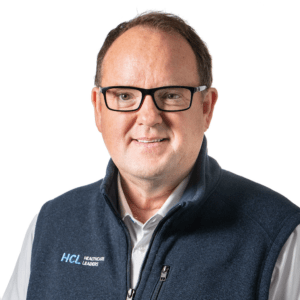Telemedicine for Parkinson’s
A unique and innovative telemedicine project is providing residents suffering with Parkinson’s disease at the Presbyterian Home and Rehabilitation Center, New Hartford, NY, access to neurologists at the University of Rochester Medical Center. It is the first Parkinson’s disease telemedicine program in the country.
Tony Joseph, administrator for the past 10 years at the Presbyterian Home, was the catalyst for initiating the program. “We [nursing homes] do a great job with Alzheimer’s, diabetes, and short-term rehab stays, but we’ve done a lousy job of taking care of residents with Parkinson’s.” Joseph says the reason is there aren’t the numbers-only 1.5 million diagnosed Parkinson’s cases. With diabetes, there are 30 million patients over the age of 65. When the nursing home opened in 2001, it was the first in the nation to offer specialized care to people with Parkinson’s and other movement disorders in a nursing home setting. For years, the Parkinson’s patients at the home would typically make 10 trips a year to Syracuse, Albany, or Rochester to see a movement disorders specialist. Joseph says the trips were exhausting for the home’s elderly patients. “I knew there had to be a better way,” he says.
Getting started
About 15 years ago, Joseph made a guest presentation to the Central New York Parkinson’s Support Group (CNYPSG). He knew then, if he ever moved back to the area, he wanted to partner with them to help Parkinson’s sufferers. That happened in 1999 when Joseph arrived at the Presbyterian Home, a 250-bed nursing home near Utica, New York. “The CNYPSG gave us direction. I asked them what their frustrations were with the disease, and among them was the distance they had to travel for various consultations.” Group members explained that if they were in an area that didn’t have movement disorder specialists, they would be referred to facilities sometimes more than a hundred miles away. “For people in their 70s or 80s, that’s a long day when you add up travel time, meals, taking a wheelchair, parking, getting to the physician’s office, waiting for the physician, the appointment, and then traveling home.” The idea of pairing telemedicine and Parkinson’s was born.
Joseph was working with some high-tech people and explained the challenges Parkinson’s sufferers face. They thought videoconferencing, even though it was an old technology, would be perfect for consultations. Joseph then hit the road looking for a medical facility to partner with. He says he “hit pay dirt” with Ray Dorsey, MD, and Kevin Biglan, MD, at the University of Rochester Medical Center, 150 miles from the Presbyterian Home. The Medical Center has one of the largest movement and inherited neurological disorders programs in the nation with more than 10 physicians and has been designated a Center of Excellence by the National Parkinson’s Foundation and the Huntington’s Disease Society of America. Drs. Biglan and Dorsey were also involved with the CNYPSG.
Telemedicine is used successfully in other disease conditions. It is used in Canada for Parkinson’s. The Presbyterian Home/University of Rochester project would be the first time it was being used for Parkinson’s in the United States. “We were certainly intrigued by the idea,” Dr. Biglan tells Long-Term Living. “We do a lot of research, so we were interested in whether or not we could take care of Parkinson’s patients using telemedicine. Most of what we do as far as examination of patients is very visual; a lot of it is history. So we thought this might be a good disease to model and see if telemedicine would work.”
An initial pilot project, funded by grants Joseph found, followed 14 patients for six months and then evaluated the outcomes of those who received care through telemedicine and those who did not. The study found that telemedicine patients had significant improvements in quality of life and motor function. In addition, those receiving telemedicine had trends toward higher satisfaction with their care. The project was so successful that it was continued for another year with grant funding from New York State. “The satisfaction is high on both ends,” Joseph says.
How it works
Joseph spent $35,000 five years ago on a laptop, 42-in. screen, a microphone, and a camera. “Right now,” Joseph says, “you can probably get what I bought for $5,000.” Ana Appler, RN, the nurse manager on the Parkinson’s unit at the Presbyterian Home, went to the University of Rochester to study under Drs. Biglan and Dorsey. She initially assisted on the patient-end of the consultation. The caregiver is also welcome during the consultation, which lasts 35 to 40 minutes. A room is set up at Presbyterian Home with the technology to accomplish the “virtual” visit. Dr. Biglan says establishing a doctor/patient relationship has not been an issue at all. “The one thing we did discover during this process was that one of the assessments we like to do with Parkinson’s patients is to passively move their limbs. We can’t do that because we’re not in the room with the patient,” Dr. Biglan says. “We tried to train the nurse to do it and give us feedback, but we found that the reliability between how we rated people and how they did was not as good as it could be.” But the positives far outweigh the negatives. Says Biglan, “Our ultimate goal is to provide high-quality, cost-effective care to Parkinson’s patients no matter where they live. Telemedicine allows us to do this.”
The Presbyterian Home currently has about 30 Parkinson’s residents. Joseph says that once word got out that they had such a unique way of treating Parkinson’s they had more people moving into its independent and assisted living facilities as well as attending its daycare program. “Prior to opening the Parkinson’s unit and offering this, our catch basin was a 12- to 14-mile radius around our nursing home. Now it’s extended out to 40 miles,” Joseph says. “We actually had a physician who had Parkinson’s come here from Syracuse, which is 50 miles away.”
Biggest hurdle
The Parkinson’s patients at the Presbyterian Home and surrounding community love that telemedicine allows them to see a specialist without traveling. Drs. Biglan and Dorsey love the fact that they can now help many more Parkinson’s patients than before. Sounds like a win/win situation and it is. However, how to get reimbursed for costs and services rendered is the biggest obstacle. Joseph believes that once reimbursement is available and insurance coverage pays for it, everyone will be treating Parkinson’s via telemedicine. He guesses reimbursement is about three years down the road. “It’s such a good modality,” Joseph says. “I understand concerns about the integrity of the Internet and to make sure fraud isn’t occurring, but these challenges can be overcome.”
Joseph is also starting a diabetes residence at the Presbyterian Home and will be using telemedicine for that disease process as well. “We’re very excited about this. When we first started out, this whole project was an albatross and I was hearing, ‘Well, Tony, you spent $35,000. Now what are you doing with it?’ I think we’ve shown through the success of this program what we did with it.”
Tony Joseph can be reached at (315) 272-9300, ext. 2201, or e-mail ajoseph@presbyterianhome.com.To send your comments to the editor, e-mail mhrehocik@iadvanceseniorcare.com.
Sidebar
At a glance…
The first Parkinson’s disease telemedicine program in the country is providing residents at the Presbyterian Home and Rehabilitation Center, New Hartford, NY, access to neurologists at the University of Rochester Medical Center.
Long-Term Living 2009 September;58(9):28-29
I Advance Senior Care is the industry-leading source for practical, in-depth, business-building, and resident care information for owners, executives, administrators, and directors of nursing at assisted living communities, skilled nursing facilities, post-acute facilities, and continuing care retirement communities. The I Advance Senior Care editorial team and industry experts provide market analysis, strategic direction, policy commentary, clinical best-practices, business management, and technology breakthroughs.
I Advance Senior Care is part of the Institute for the Advancement of Senior Care and published by Plain-English Health Care.
Related Articles
Topics: Articles , Technology & IT











